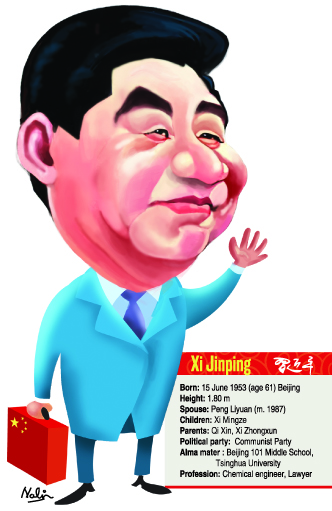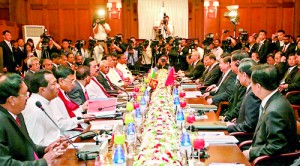News
With all that ink China leaves behind indelible mark
Sri Lanka did not do anything in halves for visiting Chinese President Xi Jingping. After his office said he liked elephants, 40 of them were brought to Katunayake for his arrival Tuesday.

Elephants were lined up so that President Xi Jinping could gaze at them while rolling by in his motorcade. Pix by Indika Handuwala
The animals were dressed up and placed in a line so that Mr Xi could gaze at them while rolling by in his motorcade. At the top of the lane were two majestic tuskers. And waiting in the shade nearby was the National Zoological Gardens’ Elephant Tranquiliser Unit.
The organisers had pulled out all the stops. The same gathering of 3,200 schoolchildren who had greeted Japanese Prime Minister Shinzo Abe returned to the scene. They wore traditional dancewear from around the country.
This time, 150 of them were brought onto the airport apron to dance as the President and First Lady Peng Liyuan alighted from their Air China plane. A mass of younger students waved flags and sparkly pompoms. They were joined on the tarmac by professional dancers, instrumentalists and “sesath” bearers.
 With Mr. Abe having arrived just the week before, some comparisons were inevitable. “The Japanese Prime Minister had wanted the outdoor ceremony cancelled if it rained,” said one of the organisers. “The Chinese President had said only a flood would stop him and that all he needed if it rained was an umbrella.”
With Mr. Abe having arrived just the week before, some comparisons were inevitable. “The Japanese Prime Minister had wanted the outdoor ceremony cancelled if it rained,” said one of the organisers. “The Chinese President had said only a flood would stop him and that all he needed if it rained was an umbrella.”
In addition to elephants, Mr. Xi must also like drummers. At the launch of the Colombo Port City the following day, there were no less than 200 of them flanking the red carpet. They struck up a traditional beat as he and President Mahinda Rajapaksa walked up to inaugurate the US$. 1.3 billion dollar project.
Numerous hoardings advertised the proposed 233-hectare artificial island. The Chinese will have effective control of 108 hectares—20, on freehold basis; 88, on a 99-year lease. The Sri Lankan Government will have 62 hectares to develop as it sees fit.
The remaining 63 hectares (also listed in the Government’s portfolio) is reserved for common amenities such as roads. A press release distributed at the event said that the project proponent, C/c China Communication Construction Company, “will be granted a land area which will be sufficient to earn back the invested amount”.
A Sri Lanka Ports Authority (SLPA) official confided that the Chinese company had contributed towards the cost of the ceremony. The two Presidents also toured the adjoining Colombo International Container Terminals Ltd, in which another Chinese company—China Merchants Holdings (International) Co Ltd—has 85 percent controlling share. The SLPA holds the rest.
One of the world’s largest container vessels, owned by China Ocean Shipping (Group) Company or COSCO, was docked at the CICT jetty. “It was in the area and they brought it here in time for the Chinese President’s visit,” said another SLPA official.
At the Presidential Secretariat on Tuesday, restricted bilateral talks involving the two Heads of State and key figures (such as Defence Secretary Gotabaya Rajapaksa and Economic Development Minister Basil Rajapaksa) went on for more than half-an-hour. They had been scheduled to last only 15 minutes.
“This led to the general bilateral being shorter,” said a senior bureaucrat. “They didn’t have much to discuss there.” At closed-door discussions, Sri Lanka raised the issue of human rights and sought China’s continued support in international forums.
China focused heavily on maritime issues (as had rival, Japan). “Their main objective was the whole maritime Silk Road initiative,” the bureaucrat said, requesting anonymity. “Their interest was not just economic but strategic. For Sri Lanka, however, the maritime Silk Road is not just strategic but economic.”
The bilateral meetings were followed by the signing of agreements. One of these was a “Plan of Action of the Democratic Socialist Republic of Sri Lanka and the People’s Republic of China to Deepen the Strategic Cooperative Partnership”. This is typically known as a joint statement.
In neither of the other countries President Xi visited—Maldives or India—was a plan of action entered into. In Maldives, there was a “Joint Press Communiqué between the Republic of Maldives and the People’s Republic of China”. In India, it was called the “Joint Statement between the Republic of India and the People’s Republic of China on Building a Closer Developmental Partnership”.
Nevertheless, there were commonalities in the statements, particularly with regard to maritime cooperation and security. “The Chinese side proposed the template,” a senior official said, requesting anonymity. “The skeletons are similar.” But while Sri Lanka and Maldives expressed unequivocal support for the maritime Silk Road, India did not.
In keeping with the theme of “big and plentiful”, a significant volume of other agreements were signed in Colombo. The Legal Division of the Ministry of External Affairs (MEA) was overwhelmed. Such a large number of agreements had never previously been signed on a single bilateral visit.
Behind the scenes, there was great concern that procedures (such as Cabinet approval, clearance by the Attorney General and the MEA) were not being followed. “Twenty-seven agreements were signed in the presence of the two Presidents but there was a whole separate list,” said the senior official earlier quoted.
With all that ink, the Chinese left a strong impression that they were in for the long haul. “It was cleverly done,” said one observer. “The direct liquidity impact on the economy was visible. That is driving public opinion. Most of it was loans but there was also a grant component.”
As for President Xi, he had been thrilled with the elephants. He was also touched by President Rajapaksa’s final gesture towards him. Despite the official programme saying the Prime Minister would send him off at the airport, President Rajapaksa and First Lady Shiranthi had turned up instead. The Chinese Embassy later made it known that it had made Mr. Xi very happy.
| How did they get in? Chinese journos no jacket, no tie
Looks like a few errant journalists—nearly all of them Chinese—slipped through the icy grip of President Mahinda Rajapaksa’s fashion police this week.  China- Sri Lanka bilateral talks in progress The office of the ‘Presidential Spokesman and International Media Unit’ had issued a stern warning (bold, underlined) that no journalist out of formal attire would be tolerated at the China-Sri Lanka bilateral talks. The media advisory said: “The dress code for media personnel is formal (jacket preferred, minimum tie).” “All media personnel are kindly requested to follow the dress code as it will be strictly enforced,” it said. “Those who are not in the appropriate attire will not be granted access to cover the event. No exceptions please.” But what was seen in the hall at the Presidential Secretariat were “exceptions”. While a large number of local journalists did adhere to the enforced dress code, many visiting Chinese cameraman were in shirtsleeves—no jacket, no tie. A photograph circulated by President Rajapaksa’s office even shows one in a t-shirt and two in short-sleeves. Several more can be seen dressed in smart casual, as journalists are wont to do in most parts of the world  The section in the circular that emphasised the dress code The previous week, several Colombo-based foreign media correspondents had been barred from covering the bilateral meeting between President Rajapaksa and Japanese Premier Shinzo Abe for want of jackets and ties. They were allowed in after a compromise was reached: that the next time they covered an event involving a Head of State or Government, foreign correspondents would wear ties while a blazer would be an added incentive. A new advisory with the contents quoted above was issued. It notably had no instructions for female journalists. It seemed to specifically target media based in Sri Lanka and not visiting journalists. And it clearly did not mean “no exceptions” in the usual sense of the phrase. Exceptions to the exceptions were acceptable when bossing those exceptions around was out of the question. |

